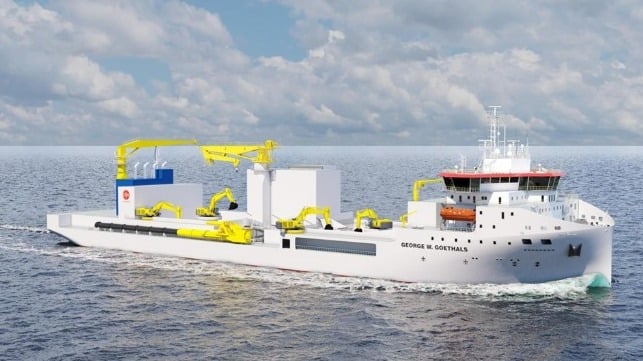Jan De Nul Offers Subsea Cable Protection for an Era of New Security Risks

In response to concerns about the vulnerability of subsea cables in an era of "hybrid warfare," the marine construction experts at Jan De Nul have a solution: protect them. Industry already has methods to protect subsea installations against scouring or stray trawler nets, and the same techniques could be applied to defend cables from hostile divers, robotic subs and ship anchors.
Jan De Nul has ordered a new rock-dumping ship that is designed to respond to the needs of infrastructure owners in the North Sea and Southeast Asia, where offshore wind power is expanding. The vessel is designed to protect cables, pipelines and other undersea structures by installing a heavy rock cover layer.
Named the George W. Goethals, the vessel has a capacity of up to 37,000 tonnes and comes with a flexible vertical fall pipe and an inclined fall pipe system. As equipped, she will be able to install extra-large rocks to water depths of up to 400 meters - well within scope for bottom-fixed offshore wind farms and most North Sea and Baltic Sea cables routes.
The Goethals will run on biofuel and green methanol, which significantly reduces CO? emissions. A hybrid power plant also guarantees efficient fuel usage. The vessel will be equipped with four electric excavators for loading large size rocks, without a conveyor belt or crane on shore.
“Decades of hands-on experience have given us deep expertise in subsea rock installation. We have applied this knowledge throughout the vessel’s design. The collective capacity of our subsea rock installation fleet now surges beyond 100,000 tonnes. This investment will strengthen our leading position in the industry,” said Philippe Hutse, Jan De Nul Directeur Offshore Energy.
Apart from the new rock installation vessel, the company is also building two extra-large cable-laying vessels that will have a cable-carrying capacity of 28,000 tonnes, which is more than any other vessel currently on the market. The two cable-layers - named Fleeming Jenkin and William Thomson - are designed to install cables over longer distances with fewer subsea connections, making them ideal for interconnector cables that link energy grids across the globe.
